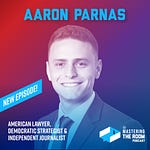Earlier this year I was was contacted out of the blue by Joel Snyder, a high school government teacher from a tough part of LA. He had somehow found my book We Hold These ‘Truths’ and wanted to use it in his class to get his students to think more deeply about a government they didn’t see as accessible, let alone representative.
Mr. Snyder asked if I would be open to discussing the book and student ideas about how to reform government via zoom.
Duh.
Of course, I would. Such an interaction—especially with these types of students—was at the very top of the list of reasons why I wanted to write the book in the first place.
And boy howdy, let me tell you, the full experience was inspiring, energizing, affirming. Insert all of your positive adjectives here.
I’ll let Mr. Snyder take it from here to detail the plan we hatched to get students—and soon to be voters—to think more critically about government. All from thousands of miles apart.
Written by Joel Snyder, high school government teacher, South Los Angeles, CA
I wasn’t sure what was next, but I knew it was time for it. In the waning days of the 2024-2025 school year, looking ahead to the one that would follow, I knew that I needed some new tools to fully address in my 12th grade Government classes what was happening in our country. Since 2018, I had been using Eric Liu’s You’re More Powerful than You Think as a secondary text—and I’ve loved its analysis of power and how Americans of all persuasions can better access it. While there was still terrific wisdom and value in that text, the novel tactics of the new administration—and particularly the new responses from the other branches—required a new explainer that would help students understand and respond to this American moment with interest and agency.
Enter Casey Burgat’s We Hold These “Truths,” which (if you’re reading this Substack you already know) tackles Constitutional misperceptions clearly and forcefully from all political viewpoints. I felt that embracing how Constitutional misgivings are holding us back would approach my students with honesty, and an opportunity to grapple with ideas to fix those problems would give them agency. As I dug further into the book, I appreciated its approach from across the spectrum and became intrigued by the many access points to constitutional change it could provide as options for students. I started putting together a project model for my unit on the Constitution’s origins and centrality in American life and the largely dormant process to amend it.
When I reached out blindly to Professor Burgat to share my idea, I couldn’t have been received more warmly. I loved how excited he was to hear about his book being in the hands of mostly first-generation American teens in southeast Los Angeles, and I appreciated how quickly he saw the value in the project I was building. We chatted briefly and set up two touchpoints for my classes and his work: one during our project and one after we’d finished. We were off to the races, despite the thousands of miles between us.
As students chose issues that interested them and began to read the expert-written chapters about them, I was struck by how so many of their questions struck at the heart of political truths even I took for granted. Their surprise—as constitutional newbies—came quickly and clearly at things like the role of the filibuster, the role of money in politics, or the change in time Supreme Court justices now serve despite no constitutional language change. We sent some questions along to Professor Burgat and got answers—a real affirmation for students that their voices mattered beyond an echo-chamber of our classroom.
Then, they dug in to propose constitutional amendments. As you can imagine, they spanned from specific to general, from liberal to conservative to undefinable, from massive to minute. Students were using real tools to propose real change, and while I couldn’t confidently tell them that formal constitutional change was imminent—it’s only happened once in my lifetime, after all—they were clearly thinking about the Constitution in meaningful ways.
This was only affirmed when Professor Burgat and I arranged to have a live session with my 4th period class after they’d finished their projects. I asked for a few students to volunteer presenting their Amendments to him, and the session was the very definition of what many people in civic education call an “authentic audience.” I put my students in front of voters to discuss ballot measures, in front of their elected officials to discuss local problems, and now in front of an author (and university Professor) to discuss his book, but more importantly, their ideas. My students presented masterfully, Professor Burgat affirmed, challenged and listened to them, and the classroom felt abuzz. The digital divide seemed to (this time) allow us to do things that would be unimaginable otherwise.
Student voice was centered, my students saw two grown men geeking out over the Constitution, and we’d begun to answer my original question of what came next. As we continue to explore the fractures in our Constitutional order and how to remedy them, I’m grateful that Professor Burgat provided some of the forum to start on the right foot. Next year, I’m hoping to get him out to Los Angeles in person (but shh—don’t tell him yet).











